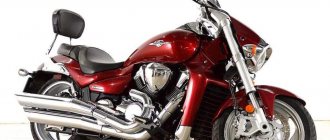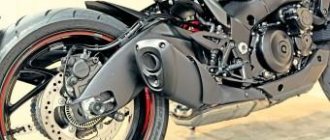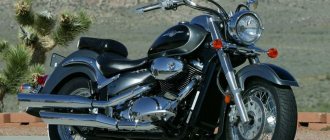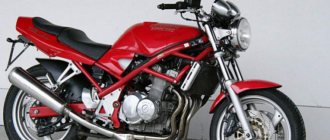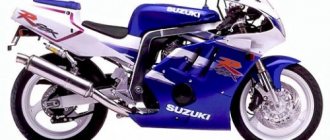Technical characteristics of GRASSTRACKER 250
| GRASSTRACKER 250 | Parameter |
| Motorcycle type | scrambler (retro classic) |
| engine's type | 4-stroke, SOHC, air cooled |
| Engine capacity | 249 cm3 |
| Engine power | 20.0 hp (15.0 kW) |
| Maximum speed | 120 km/h |
| Drive unit | chain |
| Supply system | carburetor |
| Transmission | 5-speed manual |
| Front suspension | telescopic fork |
| Rear suspension | pendulum, two shock absorbers |
In the form of a motor, Grasstracker received a conventional 4-stroke air-cooled engine with 1 cylinder.
Single cylinder engine.
Carburetor power system.
Crankcase cover.
Clutch cover.
During the restyling process, the 4-valve cylinder head distribution system was replaced with a 2-valve one . According to company representatives, it was made for easier maintenance.
Transmission and clutch
The bikes received a 5-speed gearbox .
According to reviews from the owners, it worked well, turned on clearly, and there were also characteristic clicks. And some opinions flashed that you can switch to a car. From first to fourth, and from fourth to neutral.
The main drive is standard - chain .
Classic chain drive.
Front disc brakes.
Rear drum brake.
Brakes
Being a modification of the retro version, the brakes of the bike were quite simple.
There is 1 disc on the front wheel, and a drum on the rear wheel.
Hydraulic support for the front disc is provided by a 1-piston .
In accordance with the retro concept, no frills options were offered.
Suzuki Volty (Grasstracker, TU250X, TU250G, ST250): review, history, specs
| Models | |||
| Suzuki Volty (Europe, North America, Australia) (North America, Australia) | Suzuki ST250/ST250E | ||
| Models | ||
| Suzuki ST250 / ST250E 2008 (to 2021 – sales) | Suzuki Grasstracker/Big Boy 2000-2010 (to 2021 – sales) ContentsHistoryHistory | |
| Year | Country | Name/Frame/Engine |
| 1994 | Asia | Name : Suzuki Volty |
: Suzuki Volty1997Europe, North America, AustraliaName
: Suzuki Volty1998Europe, North America, AustraliaName
: Suzuki Volty1999Europe, North America, Australia, AsiaName
: Suzuki Volty
Code:
TU250XX; TU250X
2000Europe, North America, Australia, AsiaName: Suzuki Volty; Suzuki Grasstracker
Code:
TU250XY; TU250Y; TU250GY
2001Europe, North America, Australia, JapanName: Suzuki Volty; Suzuki Grasstracker Big Boy
Code:
TU250XK1; TU250GBK1
2002AsiaName: Suzuki Volty; Suzuki Grasstracker + Big Boy
Code:
TU250K2; TU250GK2 + TU250GBK2
2003AsiaName: Suzuki Grasstracker + Big Boy
Code:
TU250GK3 + TU250GBK3
2004AsiaName: Suzuki ST250; Suzuki Grasstracker + Big Boy
Code:
ST250K4; TU250GK4 + TU250GBK4
2005AsiaName: Suzuki ST250; Suzuki Grasstracker + Big Boy
Code:
ST250K5; TU250GK5 + TU250GBK5
2006AsiaName: Suzuki ST250; Suzuki Grasstracker + Big Boy
Code:
ST250K6; TU250GK6 + TU250GBK6
2007AsiaName: Suzuki ST250; Suzuki Grasstracker + Big Boy
Code:
ST250K7; TU250GK7 + TU250GBK7
2008AsiaName: Suzuki ST2502009North America, AsiaName
: Suzuki TU250X; Suzuki Grasstracker + Big Boy
Code:
TU250XK9; TU250GK9 + TU250GBK9
2010North America, AsiaName: Suzuki TU250X; Suzuki Grasstracker + Big Boy
Code:
TU250XL0; TU250GL0 + TU250GBL0
2011North America, AustraliaName: Suzuki TU250X2012North America, AustraliaName
: Suzuki TU250X2013North America, AustraliaName
: Suzuki TU250X2015North America, AustraliaName
: Suzuki TU250X2016North America, AustraliaName
: Suzuki TU250X2017North America, AustraliaName
: Suzuki TU250X2018North America, AustraliaName
: Suzuki TU250X2019North America, AustraliaName
: Suzuki TU250X
Specifications
Suzuki Volty (Grasstracker): specs.
| Overall width | 770 mm / 30.3 in – Volty (1994-2002, Asia) 750 mm / 29.5 in – TU250X Volty (2009+), ST250 900 mm / 35.4 in – Grasstracker 910 mm / 35.8 in – Grasstracker Big Boy | |
| Overall height | 1075 mm / 42.3 in 1130 mm / 44.5 in – Grasstracker 1145 mm / 45.1 in – Grasstracker Big Boy | |
| Seat height | 750 mm / 29.5 in – Volty (1994-2002, Asia), Grasstracker 770 mm / 30.3 in – TU250X Volty (2009+), ST250 790 mm / 31.1 in – Grasstracker Big Boy | |
| Wheelbase | 1325 mm / 52.1 in – Volty (1994-2002, Asia), Grasstracker 1375 mm / 54.1 in – TU250X Volty (2009+), ST250 1405 mm / 55.3 in – Grasstracker Big Boy | |
| Ground clearance | 160 mm / 6.3 in – Volty (1994-2002, Asia), Grasstracker 165 mm / 6.5 in – TU250X Volty (2009+), ST250 200 mm / 7.9 in – Grasstracker Big Boy | |
| Dry weight | 125 kg / 275 lbs – Volty (1994-2002, Asia) 140 kg / 308 lbs – TU250X Volty (2009+), ST250 120 kg / 264 lbs – Grasstracker 123 kg / 271 lbs – Grasstracker Big Boy | |
| Curb (wet) weight | ||
| FRAME | Type | Steel backbone |
| Front suspension, travel | Telescopic fork | |
| Rear suspension, travel | Swingarm with twin-shock | |
| Front tire size | 3.00-18 47S – Volty (1994-2002, Asia), Grasstracker 90/90-18 M/C 51S – TU250X Volty, ST250 100/90-19 57P – Grasstracker Big Boy | |
| Rear tire size | 120/80-17M/C 61S – Volty (1994-2002, Asia), Grasstracker 110/90-18 M/C 61S – TU250X Volty, ST250 130/80-18 66P – Grasstracker Big Boy | |
| Front brake | Single disc | |
| Rear brake | Drum | |
| Fuel capacity | 12.0 l / 3.17 US gal 6.0 l / 1.58 US gal – Grasstracker + Big Boy (2000 to Feb. 2008) 8.0 l / 2.11 US gal – Grasstracker + Big Boy (Sept. 2008+) | |
| Trail | 107 mm / 3.6 in – Volty (1994-2002, Asia), Grasstracker 92 mm / 3.6 in – TU250X Volty, ST250, Grasstracker Big Boy | |
| Fuel economy | 2.9 l / 100 km (82 mpg) | |
| ENGINE | Type | Air-cooled 4-stroke |
| Cylinder arrangement | Single cylinder | |
| Bore & Stroke | 72.0 x 61.2 mm | |
| Displacement | 249 cm³ (15.2 cu-in) | |
| Compression ratio | 9.0:1 – Volty (1994-2002, Asia), TU250X (1997-2001), Grasstracker 9.2:1 – TU250X Volty (2009+), ST250 | |
| Valve train | Chain driven SOHC, 4 valves – Volty (1994-2002, Asia), TU250X (1997-2001), Grasstracker (2000 to March 2004) Chain driven SOHC, 2 valves – TU250X Volty (2009+), ST250, Grasstracker (april 2004 +) | |
| Max. power | 20.0 hp (15.0 kW) / 7500 rpm – Volty (1994-2002, Asia), TU250X (1997-2001), ST250 (2004-2007), Grasstracker (2000 to Feb. 2008) 19.0 hp ( 14.0 kW) / 7500 rpm – TU250X Volty (2009+), ST250 (2008+), Grasstracker (Sept. 2008+) | |
| Max. torque | 21 Nm (2.1 kgf*m) / 6000 rpm – Volty (1994-2002, Asia), TU250X (1997-2001), ST250 (2004-2007), Grasstracker (2000 to Feb. 2008) 21 Nm (2, 1 kgf*m) / 5500 rpm – TU250X Volty (2009+), ST250 (2008+), Grasstracker (Sept. 2008+) | |
| 0 to 100 km/h | ||
| Top speed | 121 km/h (75 mph) | |
| CARBURETION SYSTEM | Type | Carburetor, 1x – Volty (1994-2002, Asia), TU250X (1997-2001), Grasstracker (2000 to Feb. 2008), ST250 (2004-2007) Fuel Injection, 1x 32 mm – TU250X Volty (2009+), ST250 (2008+), Grasstracker (Sept. 2008+) |
| ID | ||
| DRIVE TRAIN | Clutch | Wet, multi-plate, cable operated |
| Transmission | 5-speed | |
| Final drive | Chain | |
| Primary reduction | ||
| Final reduction | ||
| Gear ratio | ||
| ELECTRICAL | Ignition | CDI – carbureted version Fully transistorized – Fuel injection version |
| Alternator | ||
| Battery capacity |
Images
Suzuki Volty (Grasstracker): images, gallery.
Driving performance,
The maximum speed of the motorcycle is 120 km/h . As users say, the speedometer sometimes lies a little, so you may not see such numbers, but it’s quite easy to dial them. True, moving at such a speed is not very convenient; a comfortable cruiser is 80 km/h .
Acceleration to hundreds (dynamics
The dynamics of the bike are quite good, but for a retro motorcycle. From standstill to 100 km/h in 7 seconds . According to reviews, “ you can start racing with cars at a traffic light, but when racing in a straight line, the comparison will not be in your favor .”
Fuel consumption
Consumption, according to the manufacturer’s documentation, is 3 liters per 100 km . The average distance at one gas station is 150–200 km (standard tank is 6 l ).
Description Suzuki ST 250E 2004
The description of the Suzuki ST 250E 2004 motorcycle is in the queue for publication of the article. Announcement: Today, for almost every new motorcycle that comes into being, marketers strive to carve out their own niche. This one is a road sport, this one is a recreational enduro. But what class should we include a motorcycle that has a little bit of everything? A good bike should have a reliable engine, comfortable ergonomics and simple controls...
Suzuki ST 250E is a motorcycle rarely sold in Russia, equipped with a low-power 20 hp engine. Despite the fact that good models of motorcycles have a very respectable price, and the season for their use is relatively short, the motorcycle market is developing rapidly. And if you believe the words of dealers, then some models of recently released motorcycles are selling like hot cakes at the beginning of the season, and the models brought to Russia are clearly not enough to fully satisfy consumer demand.
A motorcycle has long ceased to be an alternative to a car, and the times when this equipment was bought only because there was not enough money for a full-fledged car are forgotten. Nowadays, two-wheelers can be called technological marvels in many cases, and their cost can be compared with that of prestigious cars.
Many people have started buying motorcycles for hobby purposes as riding or even collecting them has become a good pastime for many people. Many motorcycles, for example the Suzuki ST 250E, whose technical characteristics make it possible to call the model a prestigious brand, are in demand among both beginners and experienced motorcyclists.
Currently, it is impossible to purchase a new Suzuki ST 250E motorcycle of the 2004 model year, since their production stopped 12 years ago. At the same time, the Suzuki ST 250E has excellent technical characteristics, so many people strive to purchase, if not a new, then at least a used version.
Motorcycles with an engine capacity of 249 cc. see, appeared as a result of long work of inventors who sought to create a model that was not inferior in characteristics to other versions of the motorcycle. In some cases, these models are not only not inferior, but also ahead of other motorcycles, as they have minimal fuel consumption and other excellent parameters.
Suzuki ST 250E belongs to a common class of motorcycles with an engine capacity from 125 to 250 kb. cmAs a rule, these are light and relatively low-power motorcycles. Here you will get flexible control, easy steering and low weight of the motorcycle. Therefore, such motorcycles are suitable for almost every beginner, regardless of their characteristics. The exception is motorcycles with two-stroke engines of the “sport” and “cross” classes, since bikes of this class are distinguished by more power and an extremely sharp response to the throttle, which also does not make them obedient to control.
Grasstracker Big Boy
The GRASSTRACKER Big Boy version was produced parallel to the main model and was distinguished by increased dimensions and higher ground clearance.
As already mentioned, the bike itself is considered a modification of the Suzuki TU250 Volty, but it also had its own variation, Grasstracker Big Boy .
Its differences were minimal - wheels of a larger diameter, but at the same time it received its own code.
While the main model had the TU250G, the big guy had the TU250GB.
Video
- A brief look and sound of the Suzuki TU250 Grasstracker motorcycle.
- A short review of the Suzuki Volty 250 motorcycle.
Road motorcycle Suzuki TU 250 Volty
, designed in a retro style, has been produced for more than two decades.
For a long time it was officially sold only in the Japanese domestic market, but now the model can be bought in other countries, in some of which the model is sold under the name Suzuki TU 250 Grasstracker
(this version features forks, swingarm, front wheel and a 6-liter gas tank , and in general can be classified as a dual-purpose motorcycle, that is, scramblers).
From a technical point of view, the Suzuki TU 250 Volty is an extremely simple small-capacity motorcycle, designed using archaic but reliable technologies. The high reliability of this model, coupled with its affordable price, made Volty so popular. However, in Russia this motorcycle is not very common. During the entire production, major changes to the design of the motorcycle were made only once, in 2003, when the model received an injector and a modified engine of lighter weight and improved cooling.
Peculiarities
Left shock absorber.
Right shock absorber.
Dashboard.
The features of the motorcycle included:
- 2 springs for rear shock absorber;
- drum brake on the drive wheel;
- super small instrument panel - speedometer, turn signal and neutral indicators;
- a small glove compartment under the saddle - “to smuggle cigarettes, you can’t put anything else in anyway”;
- low center of gravity, good handling and maneuverability;
- large suspension travel, allowing you to drive even on light off-road conditions without problems;
- reliability - the motorcycle is as simple as a dime, there’s simply nothing to break.
There was also a comfortable fit for people of average height. For tall people, we could recommend the “big guy” (Grasstracker Big Boy).
What do the owners think?
People who have purchased a 1250s motorcycle and have used it for a long time note the reliability and durability of the braking system and chassis. However, motorcyclists who have covered long distances on it do not give very good reviews about the ergonomics of the seat. They say that after a long trip the driver gets very tired and does not want to continue the journey.
There is a modification of the Suzuki bandit 250, equipped with special clip-ons, which does not cause any complaints, but people agree that the steering wheel must be periodically adjusted. This is not very convenient. Some motorcyclists prefer to replace clip-ons with more conventional road horns. This is where the negative reviews end.
The device does not require too much attention and frequent adjustments. However, the owner will have to refuel the motorcycle only with high-quality gasoline and comply with regulations regarding the lubrication procedure. Preventive examinations are carried out on a monthly basis.
Today, the Suzuki bandit 250 holds the title of being better than the late 90s motorcycle produced in Japan. Some experts note a long operational period with the necessary care. If the device is treated with care, it will serve its owner for 15 to 20 years without major repairs.
Brief history of the model
1994 - start of production and sales of the Suzuki TU250 series. The TU250G Grasstracker, TU250GB Grasstracker Bigboy and TU250X Volty are introduced.
1997 - Suzuki TU250X Volty model is officially sold in Europe.
2003 - the Suzuki TU250X (Volty) model receives a number of significant changes and improvements. In particular, instead of a carburetor, electronic injection with an SDTV (dual throttle) system is used, the engine receives a balancer shaft, and the block itself is made of a patented SCEM alloy, which reduces weight and improves heat dissipation. Motorcycles are equipped with an electric starter and kick (in Japanese versions).
2005 - the Suzuki TU250X model completely replaced the TU250 series.
2009 - The 2nd generation Suzuki TU250X Volty is officially sold in America.
2011 - The 2nd generation Suzuki TU250X is officially launched in Australia.
Five random articles about motorcycles:
Conversion of the ChZ-250 cross-country motorcycle into a multi-day motorcycle
Converting a CZ-250 motocross into a multi-day event Multi-day motorcycle competitions are the most versatile form of motorsports. They require excellent physical fitness, cross-country and road bike skills from the rider, and reliability, good driving performance and endurance from the car. It is not for nothing that the international six-day competition is called the Motorcycle Olympics, thereby emphasizing its importance. In 1972, the Soviet team took fourth place at the six-day competition held in Czechoslovakia. This, of course, is a success: our athletes, like the winners, did not receive any penalty points in the main competitions (the winners were identified only by special tests). But in order to climb to the podium, much remains to be done. City, republican and all-Union multi-day races are held in our country. The number of athletes participating in them is relatively small. The growth of mass popularity, in addition to organizational difficulties, is hampered by the lack of technically advanced motorcycles. By the way...
A journey of half a century. IZH-7, IZH-D, IZH-9, IZH-350, IZH-49, IZH-56, IZH-Planet-4, IZH-Jupiter-4
IZH-7, IZH-D, IZH-9, IZH-350, IZH-49, IZH-56, IZH-Planet, IZH-Jupiter On the outskirts of Izhevsk there is a monument - motorcyclists on rearing cars. It symbolizes the successes of city workers in the production of motorcycles and in the development of motorsports. Half a century ago, in accordance with the decision of the People's Commissariat of Heavy Industry, motorcycle production was organized here in Izhevsk on the basis of the experimental workshops of Izhstalzavod. Even earlier, in 1928, in these workshops, a group of enthusiasts under the leadership of engineer P.V. Mozharov designed and built prototypes of machines. However, due to the lack of production capabilities, it was not possible to launch serial production of motorcycles. Izhevsk residents began producing them in 1933. Between the two models you see in the pictures, there is a journey of half a century. We started with the IZH-7 motorcycle, which differed only in details from the simple L-300 machine with a two-stroke engine, which had been mastered by that time in Leningrad. Motorcyclists V. Vereshchako from the Donetsk region, K. Nikolaev from Perm and others contacted the editor with this wish. We present the circuit diagram of the IZH RP-2S relay (Fig. 1) and, for reference, the pinout of the transistors (Fig. 2). Rice. 1. Electrical diagram of the IZH RP-2S relay: resistors R1 - R7 type BC; R8, R9 - MLT type; capacitors C1 and C2 type K50-3; voltage values may differ from those indicated in the diagram by ±20%; R4 - selected during regulation; The devices circled in dotted lines are installed on the motorcycle. Rice. 2. Pinout of transistors: 1 - GT403V, 2 - KT315B, 3 - P216B; B - base; K - collector; E - emitter. 1979N03P31
Dnepr-11 and Dnepr-16. New items
Motorcycle with the brand “Dnepr” Motorcycle “Dnepr-11”. The “Dnepr-16” model with a sidecar wheel drive can be easily distinguished from the one shown in the picture by its separate saddles. The Kiev Motorcycle Plant has begun serial production of new machines “Dnepr-11” and “Dnepr-16”. The first replaced the Dnepr MT10-36 road model, the second replaced the Dnepr-12 off-road motorcycle. During their development, the latest requirements of active and passive safety standards, as well as the wishes of motorcyclists, were taken into account. First, let’s talk about the new components that are common to both models. These are the stroller wheel brake, parking brake, lights and combination switches. Improvements refer to design factors that improve traffic safety. The braking distance from a speed of 60 km/h has become 5 meters shorter. The mechanically operated parking brake operates reliably...
Price of Suzuki TU 250X according to sales advertisements
The maximum price of Suzuki TU 250X among the advertisements found is RUB 165,000*
The average price of Suzuki TU 250X among the advertisements found is RUB 120,000*
The minimum price of Suzuki TU 250X among the advertisements found is RUB 90,000*
Suzuki ST250 (TU250X) in Moscow
10/31/2020 150,000 rub.
TU250XT,volty250cc in Arzamas
10.19.2020 125,000 rub.
Suzuki ST250 (TU250X) in Moscow
10/13/2020 135,000 rub.
Suzuki ST250 (TU250X) 2014 in Moscow
09/30/2019 160,000 rub.
Suzuki Volty tu250x in Astrakhan
09/03/2019 110,000 rub.
Suzuki TU250X 2013 in Sovetsky
06/01/2019 165,000 rub.
Suzuki ST250 E, TU250X motorcycle in Kopeysk
05/27/2019 98,500 rub.
Suzuki st250e, TU250X in Kopeysk
07/03/2017 112,000 rub.
Suzuki volty (TU250X) in Nalchik
03/05/2017 95,000 rub.
Suzuki TU250X Volty in Vladivostok
02/06/2017 95,000 rub.
Suzuki TU250X sale exchange in Moscow
10.27.2016 90,000 rub.
Selling Suzuki TU250XS volty 2000 without mileage in Penza
10.23.2016 110,000 rub.
* Attention! Under the maximum, average and minimum of the Suzuki TU 250X motorcycle on this page, the average cost according to advertisements for sale on the Internet is indicated, without taking into account the year of manufacture, configuration and generation of the motorcycle model.
Brief history of the model
Model
: Suzuki Volty (Asia).
Factory designation:
TU250S.
1995 - no significant changes.
Model
: Suzuki Volty (Asia).
Factory designation:
TU250T.
1997 - appearance of the export modification TU250X.
Model
: Suzuki Volty (Europe, North America, Australia).
Factory designation:
TU250XV.
1998 - no significant changes.
Model
: Suzuki Volty (Europe, North America, Australia).
Factory designation:
TU250XW.
1999 - no significant changes.
Model
: Suzuki Volty (Europe, North America, Australia, Asia).
Factory designation:
TU250XX; TU250X.
2000 - Japanese modifications receive changes to the carburetor and an afterburning system to comply with new environmental emission standards. The appearance of the Grasstracker modification.
Model
: Suzuki Volty;
Suzuki Grasstracker (Europe, North America, Australia, Asia). Factory designation:
TU250XY; TU250Y; TU250GY.
2001 was the last year of production of the export TU250X (although sales of new motorcycles continued for several more years). The Grasstracker modification gets an electric starter and reduces the price of the basic version (so as not to create competition with the Big Boy) by simplifying the muffler, electrics and other parts.
Model
: Suzuki Volty;
Suzuki Grasstracker Big Boy (Europe, North America, Australia, Japan). Factory designation:
TU250XK1; TU250GBK1.
2002 - the Japanese modification of Volty is discontinued.
Model
: Suzuki Volty;
Suzuki Grasstracker + Big Boy (Asia). Factory designation:
TU250K2; TU250GK2 + TU250GBK2.
2003 - no significant changes.
Model
: Suzuki Grasstracker + Big Boy (Asia).
Factory designation:
TU250GK3 + TU250GBK3.
2004 - the new Suzuki ST250 model was introduced as a successor to the Japanese version of the Volty. The new 2-valve ST250 engine was also installed on the Grasstracker modification.
Model
: Suzuki ST250;
Suzuki Grasstracker + Big Boy (Asia). Factory designation:
ST250K4; TU250GK4 + TU250GBK4.
2005 - no significant changes.
Model
: Suzuki ST250;
Suzuki Grasstracker + Big Boy (Asia). Factory designation:
ST250K5; TU250GK5 + TU250GBK5.
2006 - no significant changes.
Model
: Suzuki ST250;
Suzuki Grasstracker + Big Boy (Asia). Factory designation:
ST250K6; TU250GK6 + TU250GBK6.
2007 - no significant changes.
Model
: Suzuki ST250;
Suzuki Grasstracker + Big Boy (Asia). Factory designation:
ST250K7; TU250GK7 + TU250GBK7.
2008 - The ST250 model receives an injection power system. Last year of production (sales of new ST250K8 motorcycles ceased in 2021).
Model
: Suzuki ST250 (Asia).
Factory designation:
ST250K8.
2009 - the Grasstracker modification receives an injection engine from the ST250. The appearance of the export modification Suzuki TU250X, which is identical to the domestic Japanese Suzuki ST250.
Model
: Suzuki TU250X;
Suzuki Grasstracker + Big Boy (North America, Asia). Factory designation:
TU250XK9; TU250GK9 + TU250GBK9.
2010 is the last year of Grasstracker production (sales of the new TU250GL0 + TU250GBL0 motorcycles ceased in 2021).
Model
: Suzuki TU250X;
Suzuki Grasstracker + Big Boy (North America, Asia). Factory designation:
TU250XL0; TU250GL0 + TU250GBL0.
2011 - Suzuki TU250X is available in the Australian market.
Model
: Suzuki TU250X (North America, Australia).
Factory designation:
TU250XL1.
2012 - no significant changes.
Model
: Suzuki TU250X (North America, Australia).
Factory designation:
TU250XL2.
2013 - no significant changes.
Model
: Suzuki TU250X (North America, Australia).
Factory designation:
TU250XL3.
2014 - no significant changes.
Model
: Suzuki TU250X (North America, Australia).
Factory designation:
TU250XL4.
2015 - no significant changes.
Model
: Suzuki TU250X (North America, Australia).
Factory designation:
TU250XL5.
2016 - no significant changes.
Model
: Suzuki TU250X (North America, Australia).
Factory designation:
TU250XL6.
2017 - no significant changes.
Model
: Suzuki TU250X (North America, Australia).
Factory designation:
TU250XL7.
2018 - no significant changes.
Model
: Suzuki TU250X (North America, Australia).
Factory designation:
TU250XL8.
2019 - no significant changes.
Model
: Suzuki TU250X (North America, Australia).
Factory designation:
TU250XL9.
Suzuki Djebel 250 was produced until 2008
The first Djebel 250 appeared in 1992, it was created on the basis of the Suzuki DR250S (DR 250R). The engine in Jebel is the same as in its predecessors, but the fork is different and the headlight has become larger.
What's good about the Jebel is that it comes with a kick starter installed right at the factory. Since 2000, even before 2000, the kick starter was considered an additional option. Until 2000, this enduro was equipped with a TM28 carburetor, but it did not perform well because it was sluggish at low speeds. Therefore, after 2000, they began installing a BSR32 carburetor on Jebel; at low speeds the motorcycle behaved well, but at high speeds it became dull.
After environmental regulations were tightened in 2008, this motorcycle was removed from the production line.
What is remarkable about the power plant?
The vehicle includes a four-stroke engine that uses high-octane gasoline as fuel. The engine has the following characteristics:
- The working volume of the cylinders reaches 250 cubic centimeters.
- The maximum compression ratio is 12.6.
- Power is 42 hp. It is achieved by rotating at a frequency of 14,000 rpm.
- The diameter of one cylinder reaches 49 mm.
- The torque is 24.5 N at a frequency of 10,000 rpm.
- The piston stroke is 33 mm.
- The engine includes a liquid cooling system.
- Starting is done using an electric starter.
- The ignition is electronic and belongs to the contactless variety.
The engine that is part of the Suzuki bandit 250 has some unique features. The traction present at low and medium speeds is insufficient. However, after the vehicle reaches 9000 rpm, the engine transforms into a power unit with great power and begins to fully utilize its potential.
The transmission includes a 6-speed gearbox. The motorcycle owner switches between them with his foot. The clutch is of the multi-disc variety and performs its functions in an oil bath. Torque from the crankshaft is transmitted to the rear wheel through a chain drive.
